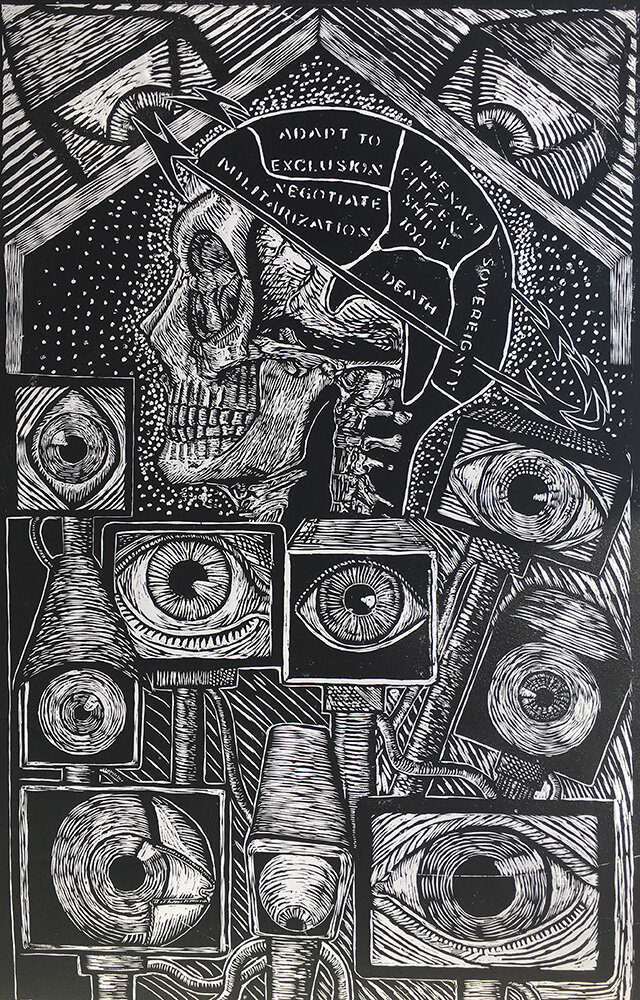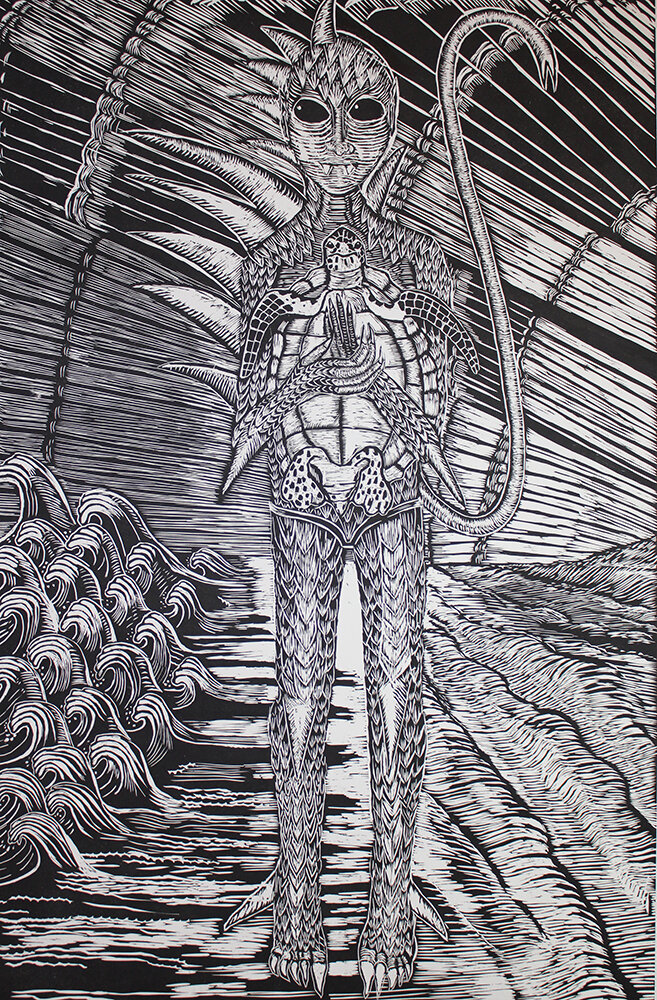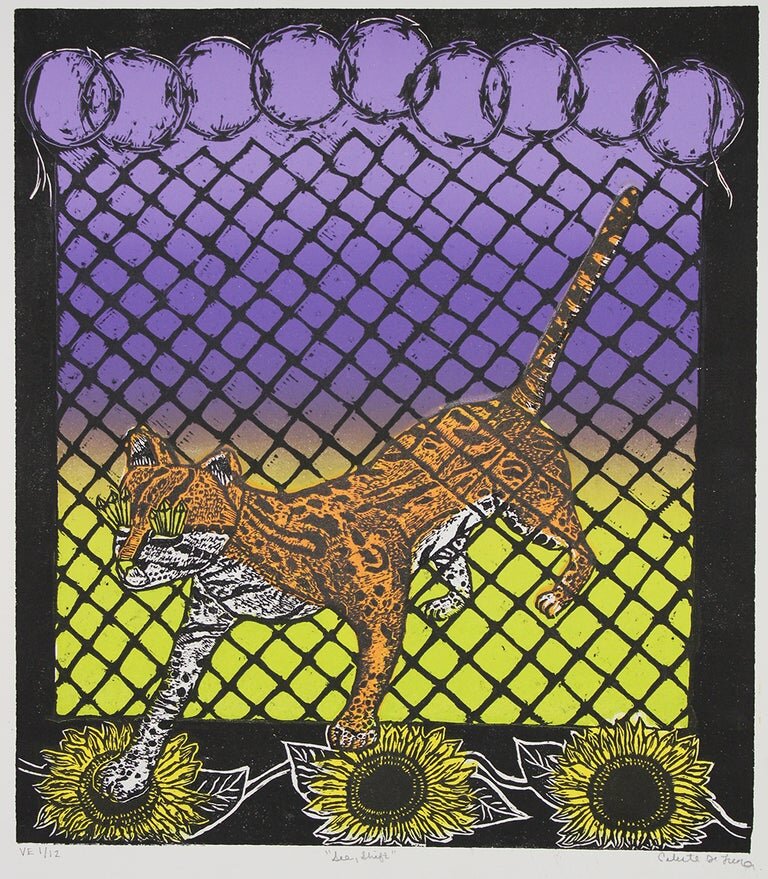






Space X at Boca Chica Beach in 2019
This is a series that I’ve been working on awhile that had it’s beginnings when I started my work with Las Imaginistas and our work with the radical imaginary on the border. We co-created projects such as Taller de Permiso and Hacemos La Ciudad with community and this naturally influenced my own practice.
The following essay excerpt “Space Exed” by my colleague, the accomplished artist Josue Ramirez writes very eloquently about many of the themes that I’m touching on in this continuing series and will continue to add to up until the present 3/24/2021
“In the deepest part of the night you followed the jaguar through the transparent wall between the worlds. Shapes shifted. Did you assume another pair of eyes, another pair of ears another body another dream body? Maybe you took your physical body, and in this other place it metamorphosed into a jaguar” ”
On May 20th 2020 a deafening explosion interrupted the call of the Hearing gulls that make Boca Chica Beach on the southernmost tip of Texas their home. Residents of the nearby Boca Chica Village felt their homes rattle, some described the event as “an earthquake.” The boom was accompanied by a burst of flames and a smoke cloud that reached the sky and trailed from the SpaceX South Texas facility. A fuel leak during a test fire of the Raptor engine caused the SN4 rocket to explode violently, scattering burning spaceship debris along the Texas gulf line. The event highlights several of the contemporary realities of the Rio Grande Valley (RGV) that a few years ago might have seemed like something out of Sci-fi. What has unfolded since the tech giant’s announcement of their South Texas project has many of the makings of speculative Fiction. Undoubtedly SpaceX leadership has a specific vision for the future of a new space station envisioning a, “truly commercial launch site like you have commercial airports.” The idea of a burgeoning private space industry enticed the State, County and municipal governments enough for them to woo SpaceX’s settlement through subsidies, access to land and cheap labor. During the groundbreaking ceremony SpaceX CEO, Elon Musk, mentioned that, “It verywell could be the first person to go to another planet could launch from this location.” Since construction of the SpaceX Boca Chica facility began in 2014 the local investment and operations for the aerospace transportation and manufacturing company increased dramatically and continues. In an eerily utopian premise the City of Brownsville now promotes itself as the“New Space City,” setting a goal for accomplishing this by 2030.
It is an unraveling narrative that intermingles the future of orbital technologies, interplanetary travel, and global capitalism with the now of La Frontera as it is currently defined by a stark socioeconomic divide, unending environmental injustices, and neoliberal policies that have historically militarized and policed Native communities and their immigration patterns. Like any riveting Sci-fi story it is full of vivid visual imagery that showcases both actuality and potentiality,in this instance of the primarily Latinx community of the Rio Grande Valley. Cues of the city's interpretation of a “New Space City” began appearing via cultural productions funded by themunicipal government of Brownsville including “community organizations,” social events, and the visual arts.
In this essay I will outline the mainstream visual narrative of “New Space City Brownsville.” I will do this by analyzing three cultural creations situated in Brownsville, Texas. I will frame the productions as propaganda for the capitalists structures of space exploration that hide the negative impacts on the local community. I will show how these creative productions carry neo-capitalist values that promote the further colonization of the local natural environment and the community resources of Indigenous, Black and Brown peoples. After defining the visual narrative of “New Space City Brownsville,” I will discuss the work of three contemporary RGV artists with a connection to the South Texas city. I will defend their work in the framework of Chican@ futurist speculative productions and as “altermundos” thatdisrupt the mainstream visual narratives of “Space City Brownsville.” By describing their work in this manner I hope to counter the mainstream visual narratives of space, the future, and modernity in South Texas. I also hope to include the work of my creative colleagues in this very important field of study of Chican@ futurism.
RGV CHICANXFUTURIST ARTISTS
Celeste De Luna is an artist whose printmaking holds a strong feminist perspective on issues that impact her intimately. Her intricate woodcut carvings and prints are known 1 for exploring themes of surveillance, la frontera, folklore, and violence on bodies of color, specifically women. She does this by referencing images of rural South Texas including local flora and fauna, tools of domesticity and symbols like skulls, eyes, decapitated bodies, and borders.
De Luna’s work steps into the realm of Chican@futurism as she provides her insight about the use of technology on border communities. She comments on militarization’s effect on the psyche of individuals under its watch in her prints “Our Lady of the Checkpoint” and Necro-Citizen.” The prints depict an imagined state of hyper-surveillance through security cameras, X-Ray technologies, allusions to Big Brother, the supernatural, the religious, and death. It is clear that DeLuna has a cautionary understanding and imagining of a future that utilizes technology to control and see through not only the subject but the viewer. In a separation from her dystopian (or actual) representations of La Frontera, De Luna expands her subject matter and provides a more optimistic vision of the current and the future world through the inclusion of the extraterrestrial and fantastical. The following will describe De Luna’s woodcut print, Chupacabra at Boca Chica Beach, as a striking anti-colonial reinterpretation of the Chupacabras and a great example of the “altermundos” of Chican@ futurism in the visual arts.The myth of the Chupacabras is one of the modern millenia appearing between 1980 and the year 2000 in primarily Latinx Communities. Translating directly into Goat Sucker, the Chupacabras was (is) a creature that haunted rural communities' farm stock. In “Sucking Vulnerability: Neoliberalism, the Chupacabras, and the Post-Cold War Years,” William A. Calvo-Quirós argues that the Chupacabras is, “more than just a naive livestock-blood-sucking Creature.”
Quiroz sees the Chupacabra as a manifestation of the “monstrous atrocities and unnatural violence inflicted on Latino/a communities on both sides of the border” by the exploitations of Neoliberalism. The global market expansion and the policies that facilitated it such as the North American Free Trade Agreement (NAFTA), threatened rural communities with brutal practices including land expropriation, poverty, and environmental racism. In a similar vein theorist Mike Davis interpreted the Chupacabras sighting in Los Angeles as “deeply interconnected to anti-immigrant sentiments and the direct attacks on immigrant communities living in California during the early 1990s.” The Chupacabras can therefore be understood as, as an “avatar of poor people’s deepest fears” when faced with “new levels of violence.” Like many creations of the phantasmagorical and horror genres, the Chupacabras can be seen as “a medium of oppression.” But one, as Quiroz explains, to be expropriated and enact “emancipatory social change.” DeLuna’s woodprint is a perfect example of that expropriation as it turns the anxiety attached to Chupacabra into a speculative tool to change existing narratives and as a call for environmental justice. In the context of the current (Space City Brownsville) the Chupacabras is once again used to symbolize the anxieties caused by a new wave of Neoliberal Capitalism that is creeping into the coast along the border through the introduction of space privatization via SpaceX.
The SpaceX Boca Chica facility brought with it many of the same violent capitalists (andcolonial) practices that impacted communities in the 90’s due to NAFTA. Land buyouts by SpaceX included local communities like Boca Chica Village, where longtime residents were pushed out because of concerns for their safety. It was reported that residents met with SpaceX CEO Elon Musk and described it as, “sort of testy” when their concerns were discussed. Residents expressed they wanted an offer that was, “not just reasonable but actually on the generous side.” Their expectations are understandable as their once serene neighborhood is unique, away from the general Brownsville population with the beach at walking distance. The fact that residents have to haggle with a multi billion dollar corporation as they are being displaced carries capitalistic trends. In addition to individual land loss there is a collective loss of public land to the RGV community and other visitors. SpaceX has a public calendar announcing the closure of Highway 4 that leads up to Boca Chica Beach. They have closed numerous amount of times since, often requiring local authorities decree. There is also a loss and immediate danger to the local wildlife. Boca Chica Beach is the nestingground for the Kemp ridley sea turtle, “one of the most endangered turtle species in the world.” The danger that is touted as a reason to move people is also a danger for the turtles.Explosions like the one that occurred in May 2020 are foreseeable considering SpaceX plans tobuild more powerful rockets on site.
The beach is not the only thing that SpaceX threatens. The introduction of the astro capitalist to the RGV came with millions of dollars in lost subsidies for local communities, placing market expansion over general quality of life. The RGV remains one of the poorest communities in the United States, the gap in inequality is huge, and SpaceX will only add to the inequity by continuing to suck the resources from the community. The cheap labor used to create the station was also a draw for SpaceX. It resembles the effect of NAFTA on border communities through the maquiladoras that became definitive of the economies of Northern Mexico.
Offering the jobs of the future is impressive but relaying to communities that those jobs will not be filled by locals because the lack of professional capacity does not come across. In 2012 the then Texas Workforce Solutions Cameron Executive Director Pat Hobbs spoke of the unemployment in the region which was “well above the national 8.1 average and 7.1 state average.” Hobbs stated that “there are jobs out there for the taking, but many times there are not enough qualified workers.” He continued to say that the available jobs are, “either management level or technician jobs” and that “most of the people don’t qualify for them.” According to Hobbs the job growth in the County grew with the population but a “significant event that would cause a major impact on the economy and the job market” had been lacking.
He suggested a company like SpaceX could come “into the area to create that change.”The fact of the matter is that the jobs that define the space industry like engineers, mathematicians,astronauts, scientists and technicians will most likely not be the jobs of RGV locals. This is mainly because of the huge gap in educational and technical capacity. Eight years after Hobbs comments, the article, “New Space City” was published in 2012 by RGVision Magazine. In it author Amy Casebier covered a lecture series titled “New Space Brownsville.” When reporting the benefits to the local economy the panel states that the jobs that are created by a “viable spaceport aren’t all limited to engineers and astronauts. Support staff like janitors, cafeteria workers, and other positions are critical — especially if those individuals can get security clearance.” By doing so she points out the level of socioeconomic nequity in the RGV and also continues to relegate stereotypes of the docile Mexican on the local communities. Having a “viable workforce to support all that economic activity” was a priority for SpaceX but only for those who behave. The introduction of astro-capitalism intoBrownsville, Texas has already had severe consequences for the local community yet these issues are hidden through the narrative of New Space City Brownsville. De Luna’s woodblock carving counters this narrative and through her reimagining o f the Chupacabras.
The print features a smiling creature carefully holding a joyful sea turtle close to its chest as thewaves of the gulf flow and the rays of sunrise glow in the background. The Chupacabra stands on two legs with sharp talons and a spiked scale exterior. It’s long forked tail curls above its head in the shape of a cane, as hornlike spikes protrude from its head to its lower back. The Chupacabras’ facial features bring to mind the “grey aliens” of popular culture with its oval head and slanted black eyes. The creature smiles shyly with its fangs visible yet un-menacing as its claws carry a sea turtle with calmness and care. The turtle the Chupacabras holds is a reference to the natural fauna of the Gulf of Mexico but also as a metaphor for immigration and to indigenous mythology and knowledge around the world. The turtle alludes to the environmental impacts on sea life by pollution and consumerism. The Chupacabras is centered between the imagery of the waves, an allusion to movement, the passage of time and the connection between the celestial and earthly. The cresting waves callto mind momentum, power, and they resemble a sea of raised fists, a callback to social justice imagery. De Luna’s visioning is a twist on the current understanding of the phenomenon as it flips its narrative. Rather than portraying a resource-sucking, fear-inducing creature, she transforms the Chupacabra into a benevolent protector of an ancient species representative of the earth itself. By doing so De Luna shows a calm aspect of the manifestation and therefore breaks from dualistic framework of good or bad and considers a different approach in generalizing a rural community's reactions to the “futurist” forces encompassed in the Chupacabras. De Luna’s print creates what Catheryn Josefina Merla-Watson terms, “altermundos” or “third space visions that are at once grounded in concrete realities while looking toward the decolonial and utopian(355).” Merla-Watson’s idea of “altermundos” is based on the concepts of ”altermondialism,” Alicia Gaspar de Alba’s (1998) “AlterNative,” and Laura Perez’s (2007) “alt a rty.” The latter of the two’s focus being identifying practices that decolonize aesthetics and the first a utopian view on globalization. Altermundos show perspectives that break from Eurocentric thoughts like capitalism, Western Dualism, heteronormativity and the patriarchy. They propose newmultidimensional decolonial visions grounded in actuality and the, “lived experiences and histories of Chican@s.”
De Luna imagines an “altermundo” where the Chupacabras, representative of regional anxieties of the future, defends and cares for the natural, the historic and the present. The image acknowledges the community’s anxiety but shows a more controlled representation because there is an understanding of the causes of the manifestation. The source of the anxiety comes from the fear of losing the landscape, the fauna, community resources and metaphorically the native history, knowledge and natural patterns of migration. By portraying the creature in such a way De Luna expands and questions the contemporaryimagining of a community's response to the pending depletion of resources and the dealing of collective trauma. She imagines a space where the anxiety about the fictitious world we live in is not seen as unnatural or even otherworldly because they are very real and rational ways of dealing with the trauma of colonialism. Like Quiroz mentions, the Chupacabra can be, like all speculative creations, “a tool for the discourse of power.” Through this discourse comes healing, understanding and the strength to joyfully enact actions to ease the roots of our anxiety. De Luna creates an altermundo where fear is used to understand ourselves more deeply and in doing so changes the perceptions of how Latinx communities can deal with generational trauma. Additionally she alters the notions of the Chupacabras, specifically the hypothesis that “as omnipresent, these creatures equally cannot be captured, domesticated, or killed.” De Luna asks, “What if we don’t have to capture, domesticate or kill the creature?” Rather than try to hunt down, capture or kill or the monster, the artist makes the anxieties approachable enough for one to understand that fear can be a warning of more terrifying realities or dangers than the Phantasmagorical.
In her interpretation of the Chupacabras De Luna captures the anxieties caused by a new wave of Neoliberal Capitalism in the Rio Grande Valley through the introduction of astro-capitalists SpaceX. De Lunas wood print references the earthly and the cosmological in a vision of an altermundo that counters the existing narrative of New Space City Brownsville. Her carving is an example of Chican@futurism visual art and shows the power the speculative has to break perceived notions of a Border community’s response to the collective trauma inflicted by white supremacist patriarchal capitalism. Lastly De Luna’s work helps the Chupacabras shed a newskin and develop a new identity in the Latinx imaginary.
1 http://www.celestedeluna.com/
2 In Necro-Citizen, Celeste breaks the fourth wall by having the cameras face the viewer and therefore implying that the viewer is under the same surveillance as the subject of the image.
3 https://en.wikipedia.org/wiki/Grey_alien
4 Specifically tying it to the Black Power and Black Liberation movements.
Work Cited
https://www.businessinsider.com/spacex-raptor-mars-moon-rocket-engine-blast-videos-2019-2
https://www.space.com/spacex-starhopper-aces-final-test-launch-landing.html
https://www.businessinsider.com/spacex-starship-rocket-prototype-explosion-fireball-boca-chica
-texas-2020-5
https://en.wikipedia.org/wiki/SpaceX_South_Texas_Launch_Site
https://www.texasmonthly.com/the-daily-post/spacex-plans-to-send-people-from-brownsville-tomars-
in-order-to-save-mankind/
https://www.newspacebrownsville.com/event-schedule
https://www.newsbreak.com/texas/brownsville/news/0OGkwe29/brownsville-aiming-to-becomespace-
city-by-2030
https://www.cob.us/CivicAlerts.aspx?AID=1224
https://crossroadsbtx.com/schedule/
https://starsocietyrgv.org/mission-vision/#
https://bmfa.us/boca-chica-to-mars/
https://upload.latest.facebook.com/STARSocietyRGV/posts/634337424018944
https://www.themonitor.com/2020/01/20/spacex-exhibit-opens-museum-fine-art/
https://www.texasmonthly.com/politics/the-battle-of-boca-chica/
https://rgvisionmagazine.com/new-space-city/
https://www.dallasnews.com/business/technology/2019/10/12/spacex-gives-south-texas-homeo
owners-more-time-to-consider-buyout-offers/
https://www.tesmanian.com/blogs/tesmanian-blog/musk-spacex-boca-chica
https://www.reddit.com/r/SpaceXLounge/comments/fe8uxn/spacex_boca_chica_more_starship_
production_as/
https://www.valleycentral.com/news/local-news/unemployment-rate-not-backing-down/amp/